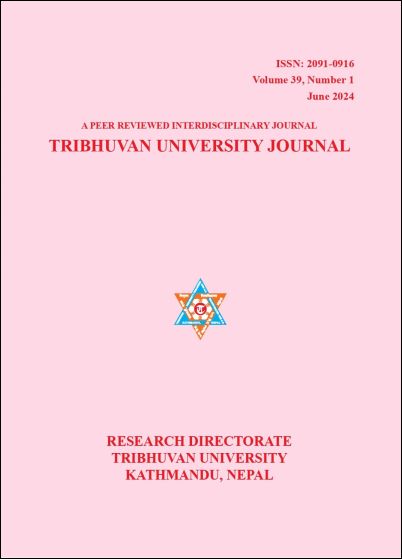Appropriation of Myth In Mahasweta Devi’s “Draupadi” and Nayan Raj Pandey’s Ular
DOI:
https://doi.org/10.3126/tuj.v39i1.66754Keywords:
appropriation, myth, contextual reading, Draupadi, social changeAbstract
Myths evolve and transform into new narratives in contemporary times through cultural appropriation as societies treat myths as vantage points to examine and interpret contemporary reality. Creative authors appropriate myths into emerging contexts to pass commentary on the prevailing reality, to derive meaning out of incoherent conditions of the time, and to make emergent situations more intelligible to the world. Popular Bengali writer, Mahasweta Devi (1926-2016) has employed Draupadi from the Mahabharata as the voice of the revolting Santhals from Bengal in the 1970s. Her short fiction “Draupadi” (1978) tells the story of a Naxalite insurgent, who sets out to participate in the armed conflict against the state in order to end economic exploitation and caste-based discrimination in her society. Similarly, Nepali novelist Nayan Raj Pandey (1966-) appropriates the myth of Draupadi by turning her into a Badi woman, sexually serving at the precinct of her society in Nepalgunj in his novella Ular [Imbalance] (1996). Devi recontextualizes the mythical Draupadi as an agent who chooses to transform the core of her society, while Pandey’s Draupadi dreams of settling in society as a family woman with her lover, Prem Lalwa. By analyzing two works of fiction, this paper explores the political goal of appropriation of certain myths in modern South Asian literature by contextually reading the text in order to explore the political goal of recontextualizing the classical narrative in the modern world. Devi's Draupadi stands at the crossroads of Bengal's socio-cultural transition in the 1970s. The author treats Draupadi as a window to look into her society and critically remark on its course of action at present. Similarly, Pandey shows the impact of the restoration of democracy in 1990 in Nepal. Draupadi loses her purity and agency in the 1990s in Nepal by letting herself be pushed to the further margins of her society.
Downloads
Downloads
Published
How to Cite
Issue
Section
License

This work is licensed under a Creative Commons Attribution-NonCommercial 4.0 International License.
This license enables reusers to distribute, remix, adapt, and build upon the material in any medium or format for noncommercial purposes only, and only so long as attribution is given to the creator.
© Center for Research, Tribhuvan University

